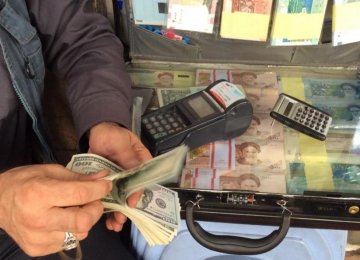The US dollar continued its rally on Saturday and was traded at 37,340 rials across Tehran's foreign exchange shops, up from Thursday's 37,060 rials. The greenback's surprise bull run started late last week and no government official has so far weighed in on the issue. Since the forex market is experiencing weak demand at the moment, this has added to the surprise of market observers.
The ascending order, which began six months ago, has seen the mighty dollar gain 5,000 rials against the rial. This has come despite the landmark nuclear deal signed in July 2015 between Iran and the P5+1 (the US, Britain, France, Russia, China plus Germany). The deal is expected to result in an easing of decade-long sanctions against Iran and renewed trade ties with the outside world in exchange for curbs on Tehran's nuclear program.
Analysts and economic observers have stated a number of reasons for the recent volatility that shook the market in the past weeks. The Central Bank of Iran points to transitory factors like a hike in demand for travel and the activities of street currency dealers. Some analysts, however, claim that the government is manipulating the exchange rates to plug holes in its budget caused by the plunge in oil prices – a barrel of crude was selling for $110 in the summer of 2014, today it is languishing below $35.
Oil prices have dropped nearly 50% since June 2015 amid low demand and buoyant production, hurting countries dependent on oil export revenues for the major part of their spending. Small wonder most oil exporters, big and small, have fallen into negative fiscal territory with possible the worst still to come.
Valiollah Seif, governor of the Central Bank of Iran, had announced lately that the greenback would soon lose ground. Now it can be said that that was rather illusionary. Some bureaux de changes consider the rise in the forex rates as natural while others point the finger of blame on the government.
However, almost everyone agrees that the long-awaited implementation of the nuclear deal and lifting of economic sanctions has kept the market on hold.
"What is certain is that with the lifting of sanctions and the release of the country's frozen assets the dollar rally will ease and possibly reverse," said Pouya Jabal Ameli, an analyst with the Financial Tribune.
Head of Iran Chamber of Commerce, Mohsen Jalal Pour said on Saturday that the banking sanctions "would be lifted within two weeks."
Safe Haven
Nasser Partovi, head of Iranian Accounting Association, attributed the recent phenomenon to the instability in the country's financial markets as middle-class families tend to keep their money in foreign exchange as a safe haven against turbulence of the national currency.
He referred to previous official data indicating that an estimated $10-$20 billion is stashed in homes and called on the CBI to take measures for attracting such financial resources into the economy that has been struggling for more reasons than one.





